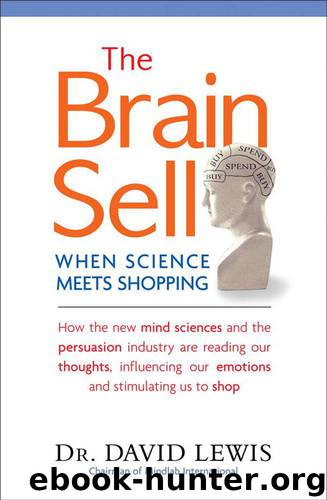The Brain Sell: When Science Meets Shopping by David Lewis

Author:David Lewis
Language: eng
Format: mobi
Publisher: Nicholas Brealey Publishing
Published: 2013-09-25T18:30:00+00:00
If brands, or cued representations of brands such as Cadbury purple, are embedded in an entertaining context, they can be influential without being consciously recognized or recalled. Cues that predict rewards are potent hidden persuaders that result in impulsive eating.
What makes a baby face?
A company making a baby product intended to illustrate its print campaign with an illustration of an attractive, smiling baby. But what sort of baby face would the intended customers, young mums, identify with most readily? This was one of the earliest studies I conducted, back in the 1990s, a good decade before the term neuromarketing was even invented. After attaching sensors to the heads and bodies of the young mothers who volunteered to take part in my research, I showed them a series of baby faces that an artist had skillfully retouched to alter minor aspects of their features.
In some, the nose had been made more snubbed; in others the smile broadened or a dimple added, subtracted, or expanded, the pupils made slightly wider or more narrow; the whole shape of the face was also subtly changed. What I was looking for here were the facial characteristics that would act most effectively as what is called a “biological releaser.”33 This relates to the fact that the young of many species—lion cubs, lambs, puppies, and human babies— share several characteristics: disproportionately large heads and big eyes. These infantile characteristics trigger a powerful protective emotion in adults and so help ensure that the young will be cared for and safeguarded during their vulnerable early years.
In addition to measuring the way the mothers’ brain was responding, their heart rate and excitement level rising or falling, we also used eye trackers to see what parts of the face were studied most closely and which were ignored. Finally, I recorded the extent to which their pupils widened or narrowed as they examined the images. This provides a good measure of their like or dislike for the baby, since the more we are attracted to something the wider our pupils become. After testing 60 subjects, I was able to identify the baby face producing the strongest emotion in the mothers, and this became the focus of an extensive and successful advertising campaign.
Engineering emotions through music
“Extraordinary how potent cheap music is!” exclaimed Noël Coward in Private Lives. That is a message that advertisers as well as musicians have long known and now neuroscientists have started to explore it. Music has equal emotional engineering power to pictures, and in some circumstances is far superior to them in triggering emotions, from joy to fear and depression to spine-tingling excitement. For instance, what are called “sonic signatures”—those short bursts of notes that introduce many news programs or announce that Windows is loading—are triggers that alert your brain almost instantly to what is happening.
In the previous chapter, I explained how music is used to manipulate everything from shoppers’ moods to the speed with which they move through a store. Here, I want to describe a study that
Download
This site does not store any files on its server. We only index and link to content provided by other sites. Please contact the content providers to delete copyright contents if any and email us, we'll remove relevant links or contents immediately.
The Art of Thinking Clearly by Rolf Dobelli(10306)
Mindhunter: Inside the FBI's Elite Serial Crime Unit by John E. Douglas & Mark Olshaker(9257)
Change Your Questions, Change Your Life by Marilee Adams(7673)
Nudge - Improving Decisions about Health, Wealth, and Happiness by Thaler Sunstein(7654)
Mastermind: How to Think Like Sherlock Holmes by Maria Konnikova(7273)
The Power of Now: A Guide to Spiritual Enlightenment by Eckhart Tolle(5672)
Men In Love by Nancy Friday(5190)
Altered Sensations by David Pantalony(5069)
Factfulness: Ten Reasons We're Wrong About the World – and Why Things Are Better Than You Think by Hans Rosling(4710)
The Confidence Code by Katty Kay(4213)
Thinking in Bets by Annie Duke(4179)
Man and His Symbols by Carl Gustav Jung(4091)
The Worm at the Core by Sheldon Solomon(3448)
Why Buddhism is True by Robert Wright(3418)
Liar's Poker by Michael Lewis(3408)
Three Women by Lisa Taddeo(3386)
The Inner Life of Animals by Peter Wohlleben(3282)
Descartes' Error by Antonio Damasio(3247)
How Music Works by David Byrne(3228)
